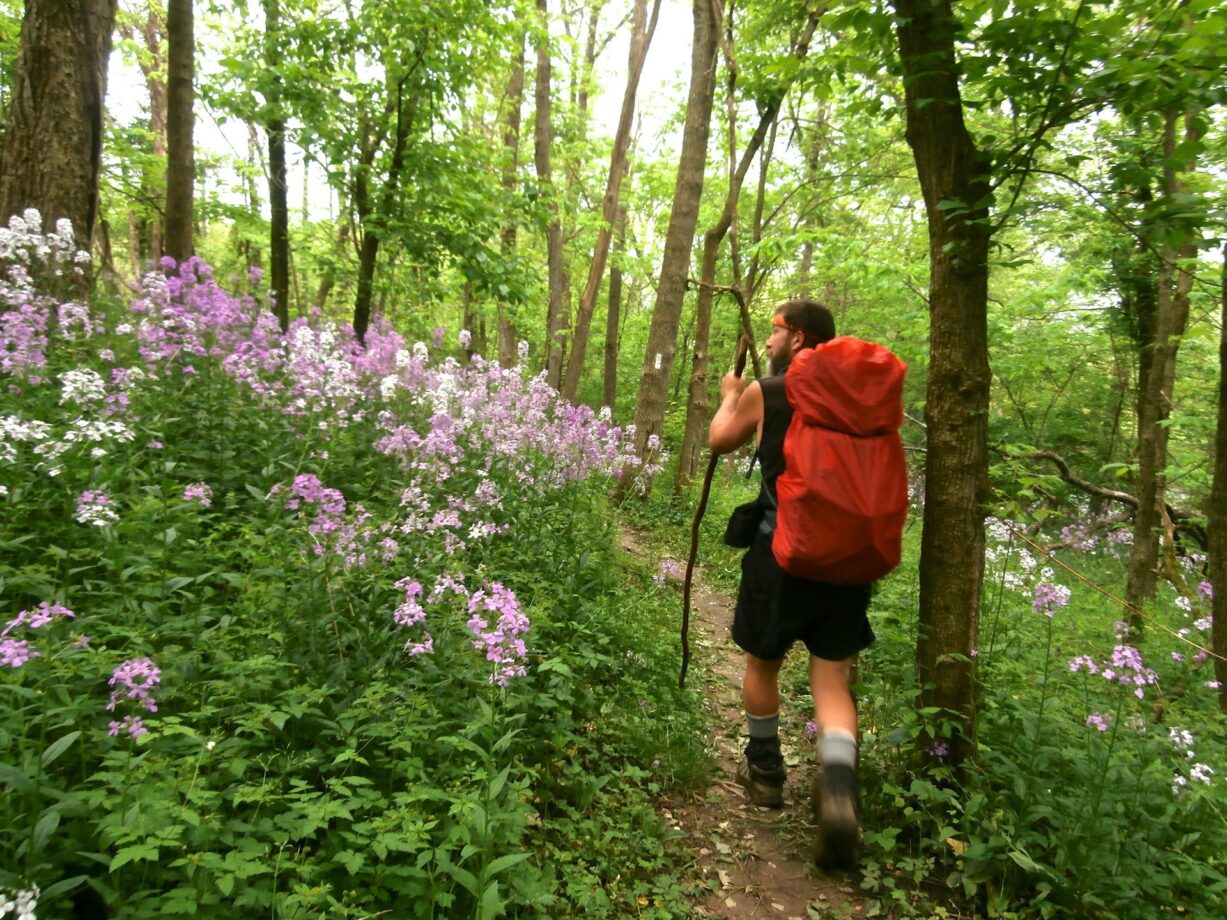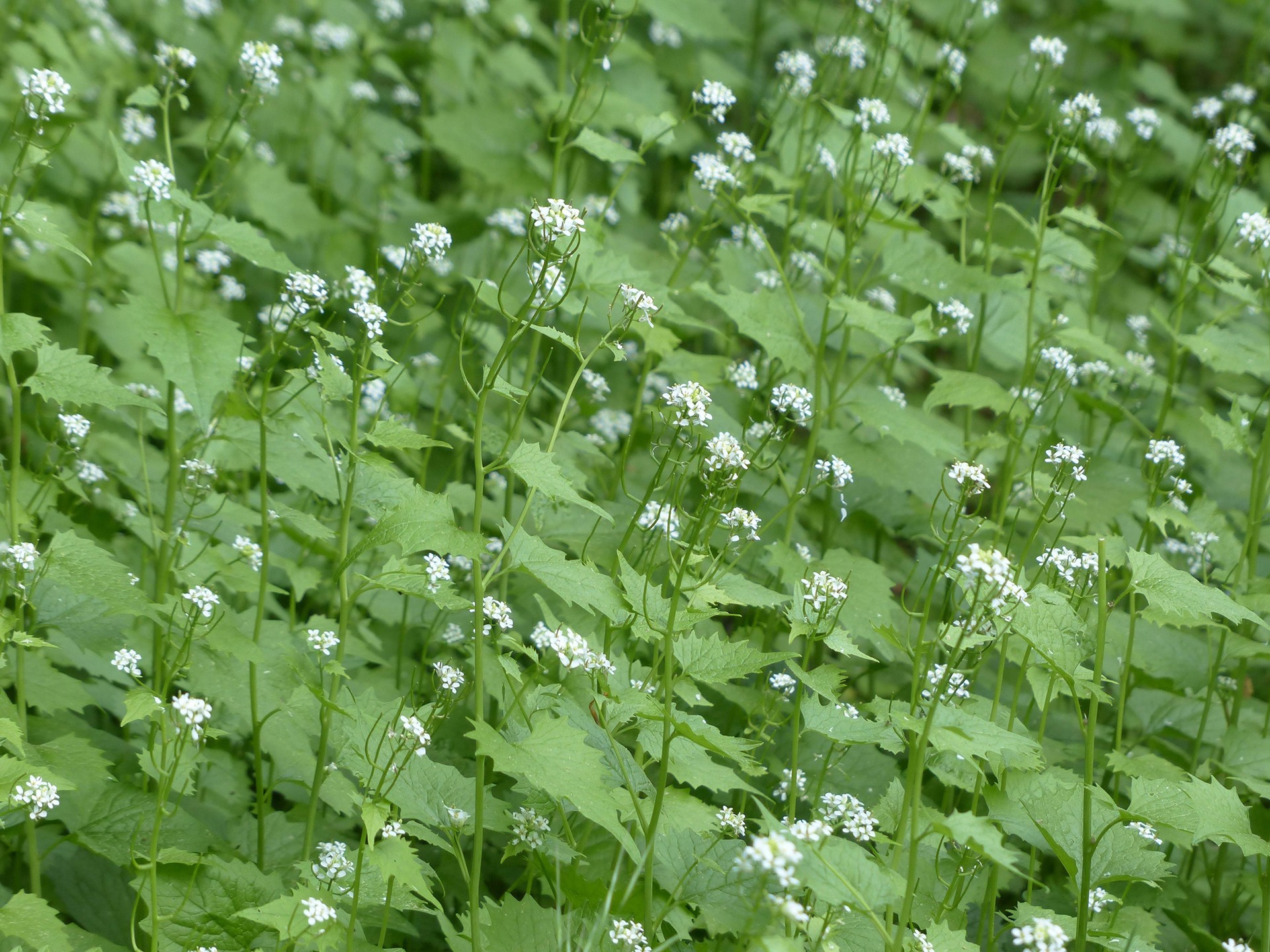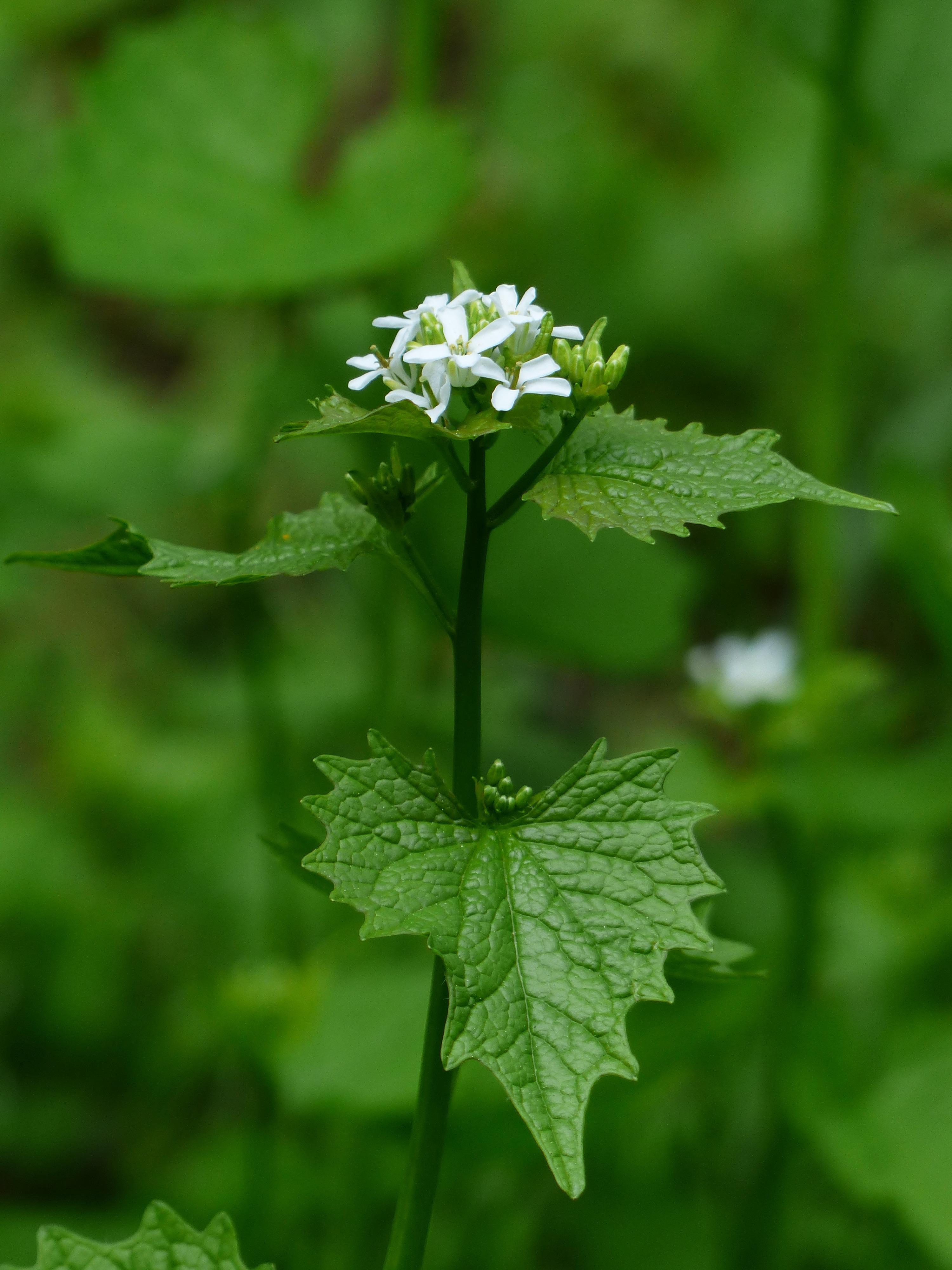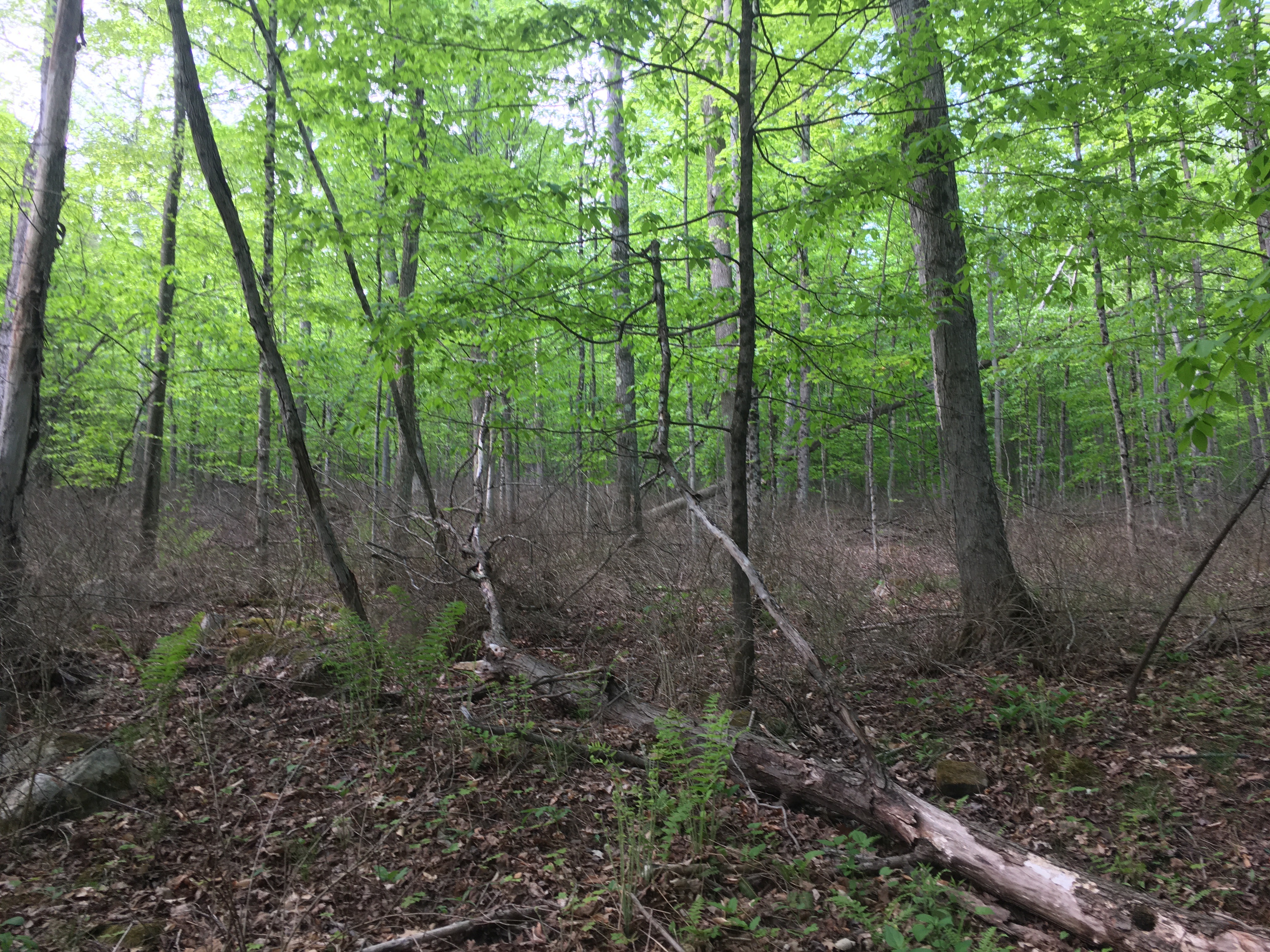Five Common Invasive Species Along the A.T. (and How You Can Help)
Jun 10, 2022

Jun 10, 2022


Photo by Suzy McKelvey
Many of us walking along the Appalachian Trail (A.T.) might think, “What pretty pink flowers!” and continue on without giving it another thought. What many of us might not realize is that this “pretty pink flower” is an invasive species — Dame’s Rocket (Hesperis matronalis) — that has the nasty habit of overcrowding native plants and leading to a less healthy environment surrounding the Trail.
Over the years, a wide variety of invasive species have taken root on the A.T. and its surrounding lands. Invasive species reach new environments in many ways, from origins near and far. Sometimes, species are carried in with international shipments of lumber or goods. In other cases, travelers unwittingly bring them in on their clothes, boots, car tires, boat hulls, etc. Some have had devastating effects, such as the blight that effectively eradicated the American chestnut from Appalachian hillsides (though there is some promising work that could one day lead to its revival). But even when they don’t reach that level of catastrophe, almost all these species have had a negative impact on the environment. They tend to be fierce competitors for limited resources — sunshine, nutrients and water in the soil, adequate space for growth, etc. In addition, they rarely have any natural predators in their introduced ranges, and native species have not evolved strong defenses against them.
But that does not mean that we have to sit back and let these invasives do their dirty work. For many of these species, there are steps that we can take individually while on the Trail to help slow their spread. In addition, the Appalachian Trail Conservancy (ATC) and its partners are working to help preserve native plants and animals and minimize the impacts of invasive species.
Below are five of the invasive species you might come across during your A.T. hikes this year:

Originating in Europe and parts of Asia, garlic mustard was originally brought to the United States for herbal and medicinal qualities, and for erosion control. When crushed, it releases the telltale garlic smell that gives this plant its name.
Garlic mustard releases its seeds into the wind in early spring, which take root and bloom before many native species even begin to sprout. The leaves of the garlic mustard block much-needed sunlight from other plants, and their roots outcompete the fledgling plants for nutrients and moisture in the soil. Chemicals released through its roots can hinder the growth of other plant species, including the underground network of fungi. Garlic mustard can quickly overwhelm the understory of forests, ultimately inhibiting the growth of everything from trillium to oak trees.
Garlic mustard blooms with bright white flowers in early spring, seeds shortly thereafter, and typically dies back by late spring/early summer. Its dried stalks might remain for many months.
Garlic mustard has been reported in every A.T. state, though it is most prevalent in the Mid-Atlantic and Northeast. You are most likely to see it in wooded areas.
The most effective way of defeating garlic mustard is to remove it manually before it releases its seeds. By completing this process over multiple seasons and making sure to get rid of every sprout, an area can be rid of garlic mustard over a period of two to five years (seeds can potentially live in the soil for this long).
 Here are some tips for manually removing garlic mustard (which are also effective for removing Dame’s Rocket, which was pictured at the beginning of this article):
Here are some tips for manually removing garlic mustard (which are also effective for removing Dame’s Rocket, which was pictured at the beginning of this article):
Every spring, the ATC sponsors localized outreach events along the A.T. to educate members of the community on the impact of garlic mustard in their natural areas. Attendees then volunteer to pull and dispose of the blooming plants. Since 2015, the ATC and volunteer groups have prevented over 20,000 lbs. of garlic mustard from setting seed and spreading further along the A.T.
The spotted lanternfly (SLF) is a leafhopper that was accidentally introduced in the United States in 2014. Native to parts of Southeast Asia, this invasive pest entered as a stowaway on a shipment of blue stone going to Pennsylvania. In a short matter of time, the SLF population ballooned in size and began spreading across the state. It is now found across more than half of Pennsylvania and in ten additional states.
The spotted lanternfly adult is approximately 1 inch long and has a very distinctive appearance. The adults have grey forewings with black spots and red and black hind wings that show through with a pinkish hue. Like the adults, the various nymph instar stages also have distinct appearances, starting as black with white spots and changing to black and red with white spots as they grow. For a detailed look at each of the SLF life stages, visit this page developed by the Cornell University College of Agricultural and Life Sciences.
The spotted lanternfly feeds on the sap of a wide variety of native plants, including grapes, apple trees, hops, maples, black walnut, birch, and willows. They often feed in large numbers, damaging plants and trees, causing stress, and increasing their vulnerability to disease. When they feed, they also excrete a sugary substance called “honeydew,” which encourages the growth of a black mold that can further damage host plants. Their impact on the nation’s forests and agriculture could be profound.
Visitors to the A.T. are currently most likely to encounter the SLF in the eastern half of Pennsylvania, but may also come across it in West Virginia, Virginia, Maryland, New Jersey, New York, and Connecticut. First, second, third, and fourth nymph instars will be seen from May to September; adults may be seen from July to December; and egg masses may be seen October to June of the following year. Be on the lookout for all three stages while on the A.T.
There are three steps you should follow when dealing with SLF on the A.T.
Inspect your tent, pack, and personal items for egg masses before leaving a resting or overnight site. SLF will lay eggs on many items, including vehicles, and hitch a ride to a new location.
Kill any SLF you do see. This goes for adults, nymphs, and eggs. Squash or smash adults and if you see egg masses on trees, scrape them off the tree and smash the eggs with a small stone or stick. Egg masses can have a grey putty-like appearance or a chain-link appearance depending on their age.
If you see spotted lanternfly eggs or insects while on the A.T., report it as soon as you can. States are currently collecting comprehensive data on SLF spread, so report to the state (and precise location) where you saw the pest. The Pennsylvania Department of Agriculture has set up a phone number and website for reporting purposes: 1-888-4BADFLY and https://services.agriculture.pa.gov/SLFReport/.
Maryland also has a reporting portal at https://survey123.arcgis.com/share/26f9dbec58674313b1bec03ddb8b5f0e.
The ATC has been working with state agencies and A.T. volunteers to spread awareness about the SLF. Signs added at trailheads and on shelters on the A.T. in Pennsylvania alert visitors to this pest. The ATC has also worked with various Pennsylvania partners to remove one of SLF’s invasive host plants, tree of heaven (Ailanthus altissima), near A.T. trailheads and road crossings.
Native to Japan and China, Japanese barberry was first introduced to North America in the 1860s as an ornamental shrub. Its appeal to landscapers is obvious when the plant produces its bright red berries in the late summer and when the leaves change from green to an alluring orange/red hue. However, Japanese Barberry soon proved problematic, escaping lawns to form impenetrable thickets layered in long thorns and growing up to 6 ft. tall. These walls of vegetation can grow thick enough to create a humid microclimate ideal for black-legged ticks that are known to carry and transmit Lyme Disease.
Japanese barberry has an advantage over native species because it flowers earlier and becomes dormant later than most native plants. This allows it to get a “jump-start” on the competition for light and resources and block out other species that will sprout underneath. Japanese barberry grows tall and fast until the weight of the stem causes the plant to droop back down to the ground. This creates a telltale “dome-shaped” line of growth.
Because Japanese barberry can grow in full sun or shade and has had many decades to expand its range in the U.S., it is possible to find it along the A.T. in most of the Trail states. It is most often encountered in Mid-Atlantic states and along the least remote sections of the Trail, near human development. It is visible at all times of the year, but it is usually easiest to identify in the late summer or fall when it produces its bright red berries.
Japanese barberry fruit and seeds are eaten by birds and can be dropped miles away from the original plant. Therefore, if you have Japanese barberry in your yard, consider removing it and replacing it with a native plant species to help contain the spread. While many states have begun to ban the sale of Japanese barberry, it can still be purchased in others. You can influence change by encouraging your local plant nursery to carry native alternatives to invasive barberry.
The ATC routinely focuses on Japanese barberry removal in locations with high native biodiversity or species of special conservation concern. ATC recently worked with Native Habitat Restoration LLC to complete a five-year restoration effort at Day Mountain, Massachusetts, focused largely on Japanese barberry removal. The invasive was treated and removed across a 75-acre area that is known for its high concentration of rare species. Ash trees were also treated against the emerald ash borer at the site in 2021 to help protect the rich native understory.

Native ferns and flowers begin to emerge on the understory at Day Mountain, Massachusetts, as dead invasive barberry treated the previous year is seen in the background.
The ATC relies heavily on training volunteers to identify and map invasive species along the Trail. If you would like to get involved, be sure to monitor upcoming opportunities listed at volunteer.appalachiantrail.org.
This highly invasive perennial grass, which is native to portions of Eurasia, was first discovered in a state park outside of Baltimore, Maryland, in 1996. No one really knows how it got there, but what quickly became apparent was how devastating this non-native invader could be. Since its introduction, wavyleaf has spread to sites in Virginia and Pennsylvania and has covered thousands of acres of public and private lands.
Wavyleaf grows in dense blankets that cover the forest floor and choke out native plant communities. It is particularly devastating because of its high tolerance to shade and its ability to quickly colonize vast areas. Wavyleaf seeds are extremely sticky and are easily carried by the hundreds, whether on the clothes of humans or the fur of deer, dogs, rodents, and other animals.
Wavyleaf can be tricky to spot because of its low-growing nature, but its distinctive leaf design makes it easy to identify once spotted. The leaves grow up to 4 inches long and have well-defined ripples that look as if someone has folded the leaf accordion style.
Visitors to the A.T. are most likely to encounter wavyleaf basketgrass as they travel through Shenandoah National Park, Northern Virginia, and Maryland.
You can reduce the spread of wavyleaf basketgrass by learning how to identify it and by staying out of infested areas from August through November to prevent seed dispersal. If you can’t avoid areas with wavyleaf basketgrass, be diligent about checking your clothing, shoes, tent, and pack and removing all seeds before leaving an infested area.
You can further help in combatting this invasive by reporting it anywhere you come across it. The best way to report wavyleaf is through the Mid-Atlantic Early Detection Network (MAEDN) mobile app https://www.eddmaps.org/midatlantic/ or its parent app EDDMapS https://www.eddmaps.org/ The EDDMapS app can be used across the country to report a wide variety of invasive species.
ATC natural resource managers work with Trail volunteers in Virginia and Maryland to search for and remove wavyleaf basketgrass. The ATC also uses the community-collected data from the MAEDN app to help identify priority management areas. We are also working to bring awareness to the issue of wavyleaf; it is likely you will see signs with more information about this species when visiting high-traffic shelters and trailheads in the Mid-Atlantic states.
One of the most prolific invasives in the Eastern U.S., Asiatic bittersweet is a climbing woody vine that is known for its fast growth and alarming ability to climb into the canopy and choke adult trees. It can be easily identified by its oblong serrated leaves and abundance of fruit that turn a bright red in fall and winter.
Like the species listed above, Asiatic bittersweet can tolerate sun as well as shade. This means it can be found along the edges of the Trail as well as penetrating into the forest. However, it is easiest to see when it is climbing trees into the canopy. Visitors will likely encounter this invader in most Trail states.
The bright red fruit of the Asiatic bittersweet is a popular wintertime decoration for American households. You can often find bittersweet vines woven into Christmas wreaths or tabletop centerpieces. While this is not problematic on its own, Asiatic bittersweet seeds can spread when people toss old decorations in their backyards, compost, or in poorly sealed trash bags.
You can help by identifying and avoiding products that use Asiatic bittersweet, and instead opting for decorations that use local native species.
The ATC regularly organizes outings to pull Asiatic bittersweet along A.T. locations. Given the widespread nature of this invasive species, these events can take place at multiple locations along the Trail. The ATC relies heavily on training volunteers to identify and map invasive species along the Trail. If you would like to get involved, be sure to monitor upcoming opportunities listed at volunteer.appalachiantrail.org.
While there are far more than five invasive species affecting the A.T., identifying and getting just one of these harmful species under control is a vital step to combating the collective impacts of invasives. As part of our mission to protect, manage, and advocate for the Trail, the ATC will continue to provide updates on the vital work it is doing to help control invasive species — and provide tips on how you can help join us in these efforts.
Get the latest A.T. news, events, merchandise, and sneak peeks delivered directly to your inbox.